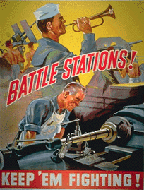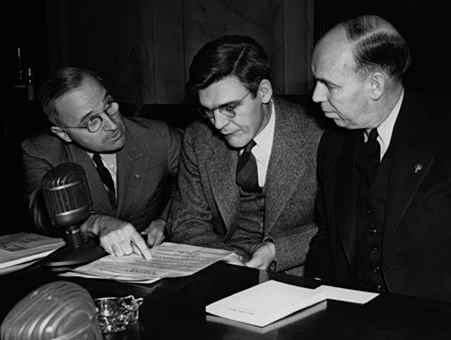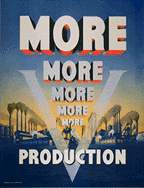The 1930s had been an era of violent labor disputes. Now the war emergency demanded a change in American industry--not only a switch from consumer goods to war materiel, but also a change in workers' and managers' attitudes from antagonism to cooperation. The government launched a campaign urging workers to make personal sacrifices to win the war, and individual businesses and labor unions quickly followed suit. Eventually, privately produced posters vastly outnumbered official government-issued posters.
For manufacturers, the war was an opportunity to gain greater control over their work force. In the push for increased productivity, factory managers called for employees to suspend union rules, abandon traditional work patterns, and make sacrifices in the name of patriotism.
Government agencies offered tips on the design and placement of posters in the factory, urging employers to "use enough" -- at least one poster per 100 workers. Plant managers, company artists, paper manufacturers, and others needed little encouragement to carry out this advice; private industry produced vast numbers of production-incentive posters during the war.

"Battle Stations!"
(Fisher Body Division, General Motors Corporation, 1942
Gift of Fisher Body Division, General Motors Corporation.)
'The Special Committee to Investigate the National Defense Program was created on March 1, 1941, to study and investigate procurement and manufacture or construction of articles and facilities needed for national defense. The committee was specifically directed to investigate the terms of defense-related contracts, the methods of awarding them, the utilization of small business concerns, the geographic distribution of contracts and facilities, and the effect on labor, as well as other matters Truman served as the first chairman of the committee, which is commonly known as the Truman Committee.
'The committee earned a high reputation for thoroughness and efficiency From its creation in 1941 until its expiration in 1948, the committee held 432 public hearings and 300 executive sessions, went on hundreds of field trips, and issued 51 reports. Throughout World War II, the committee was principally concerned with monitoring and improving production programs, contract procedures, and, eventually, reconversion plans. Much of the committee's work involved the discovery and exposure of corruption and mismanagement in the wartime production program. After the end of the war, the committee turned its attention to an analysis of wartime experiences in order to make recommendations that would improve postwar and future national defense programs. Many have called for the return of such a committee to investigate the quality of equipment and the rewarding of government contracts for the multi-billion dollar War in Iraq. Even without such an agency scandal has arisen over a lobbyist from a defense manufacturer offering favors to congressmen in return for defense contracts. These deals potentially cost taxpayers billions.

"Truman Committee"
(Uncovering Corruption and Waste)
'The media showered the committee with favorable publicity. Especially notable was the national attention brought to its first chairman, Harry Truman. It isn't surprising that the committee and its no nonsense chairman received such public approval with the enormous sums of money it saved and its uncovering of unsafe equipment being knowingly sent to American fighting forces by defense contractors.
On Jan. 17, 1943 more than a year after Pearl Harbor the S.S. Schenectady snapped in half and sank off the West Coast, only a few hours after it had been delivered to the Maritime Commission. The American Bureau of Shipping reported the sinking was due to the steel plate on the ship which was brittle and more like cast iron than steel. The US Senate's Truman Investigating Committee took over the case and at a hearing before this body in Washington on March 23, 1943, the truth came out: The defective steel had been supplied by the Carnegie-Illinois Corporation, subsidiary of the giant United States Steel Corporation, whose officials had willfully and consciously delivered faulty material to the Navy, Maritime Commission and Lend-Lease administration and had falsified the steel test records to cover up their tracks.
Testimony before the Truman Committee showed that the faking of tests had covered at least 28,000 tons of substandard plate; that minor officials and employes who had complained to their superiors about the faking of tests had had their ears pinned back; that high corporation officials instead of cooperating (with the Truman Committee) ... attempted to delay and obstruct the investigation.\ US Steel officials naturally deplored the situation, describing it as so unnecessary, and tried to put the blame on a few individuals with good intentions who had grown lax. This alibi, however, was decisively rejected by a federal grand jury in Pittsburgh in May, which refused to indict four individual employees offered as scapegoats and indicted the Carnegie-Illinois Corporation itself.
Seemingly equally indifferent to the murderous effects of its fraud was the Anaconda Wire and Cable Company whose Marion, Ind., plant (financed by the government) was indicted on Dec. 21, 1942 for conspiring to sell the government defective communication and other combat wire, although its officials well knew at all times that use of such wire would endanger the lives of men in the military service of the USA.� The Pawtucket, R.I., plant of the company was indicted a month later on similar charges.
The company was shown to have gone to great lengths to devise ingenious machinery for escaping government tests of its defective wire and thus getting the wire accepted for use by the armed forces of the United States, Soviet Union and Britain. Senator Kilgore has pointed out:
�The batteries on all our warships, including the anti-aircraft guns, are fired, controlled, aimed and ranges set, over this self-same cable, and if the cable is defective, the ship is helpless against aircraft attack. Also, the safety and success of the entire land combat forces are frequently dependent on messages sent overland by these self-same cables.�
The government charged that the conspiracy began about Nov. 1, 1940 and continued up to Oct. 1, 1942. Commenting on this, Senator Bone said:
�The fact that we were suddenly plunged into a deadly war did not in any way induce the defendants to change the criminal practices outlined in the complaint. After Pearl Harbor, and while the boys were dying on the battlefields. Anaconda and its officials continued their sordid work of defrauding the government by furnishing faulty cable.�
The case of the Wright Aeronautical Corporation, subsidiary of the huge Curtiss-Wright Corporation, holder of the second largest war contracts in the country was perhaps even more concerning. Wright's Lockland, O., plant (financed by the government) was accused by the Truman Committee in July 1943 of falsifying tests on airplane engines, destroying records, forging inspection reports, changing tolerances allowed on parts, skipping inspection operations, etc. Inspectors who complained were intimidated or transferred. These activities were aided, abetted and covered up by Army inspectors and important Army officials influenced by the corporation. The result, according to the committee's report, was:
�Engines were built and sold to the government which were leaking gasoline ... Unsafe material has been discovered In completed engines ready for delivery. The company's own reports from its field representatives indicate that these parts had failed in a substantial number of cases. A substantial number of airplanes using this engine have had crashes in which engine failures were involved ... More than 25% of the engines built at the plant have consistently failed in one or more major parts during a three-hour test run. Spare parts were shipped without praper inspection ...�
Accused of exaggerating the problem at the Lockland plant, Truman retorted:
�The facts are that they were turning out phony engines and I have no doubt a lot of kids in training planes have been killed as a result." If anything, "The Committee was conservative in its report, in order to prevent too much alarm over the situation.�
This statement typified Truman's honesty and bluntness and later helped propel him into the position as the running mate of President Roosevelt in 1944 and his subsequent succession to the Presidency.

"More....Production"
(General Cable Corporation, 1942,
Gift of General Cable Corporation.)